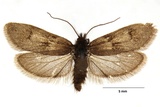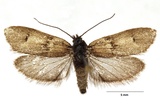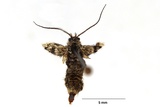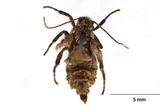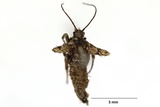Dasystoma salicella (Hübner, 1796) Species
Last modified: Dec. 5, 2025, 6:53 p.m.
A very rare and local species throughout Belgium. Nowadays most observations originate from the Kempen area.
Details
- Classification
- Family: Lypusidae > Subfamily: Chimabachinae > Genus: Dasystoma > Species: Dasystoma salicella
- Vernacular names
- Wollige kortvleugelmot (NL)
- First mention in Belgium
- De Sélys-Longchamps E. 1844. Énumération des insectes Lépidoptères de la Belgique. — Mémoires de la Société royale des Sciences de Liége 2: 1–35. On page 23 (as Lemmatophila salicella H.). view page
- Status
-
Native
Distribution
Caterpillar
Pale green; head capsule black, prothoracic plate greenish brown, darker posteriorly; last abdominal segment greenish, speckled with blackish dots.
Bionomics
The egg is oviposited in a leaf axil, under bud scales, or behind the loose bark of many species of woody plants.
The caterpillar lives between two leaves spun together. Its development is very slow, similar to that of Diurnea fagella. It has been found from May till September.
The species hibernates in the pupal stage from September till April. Pupation amongst detritus.
The males fly in sunshine around noon on warm days and assemble to females. The females have very short wings and are unable to fly. They rest on branches and trunks of trees.
Flight periods
One generation a year from March till early May, mainly observed in April.
Observed on
- Host plant (species):
- Myrica gale, Prunus spinosa, Potentilla anserina and Filipendula ulmaria
- Host plant (genera):
- Salix and Populus
- Substrates:
- Polyphagous
Polyphagous. The caterpillar has been recorded from various plants, like Acer, Alnus, Berberis vulgaris, Betula, Cornus mas, Crataegus, Filipendula ulmaria, Hippophae rhamnoides, Malus, Myrica gale, Potentilla anserina, Prunus, Pyrus, Quercus, Rhododendron, Thamnus catharticus, Rosa, Rubus fruticosus, Salix, Tilia, and Vaccinium myrtillus. It has a preference for Populus and Salix species.
Habitat
Deciduous and mixed forests with many open places, with a preference for riparian forests. Also in heathlands, gardens, abandoned orchards.
